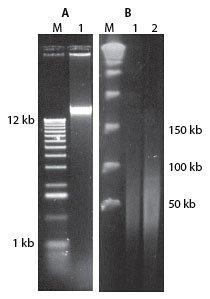The MasterPure™ Gram-Positive DNA Purification Kit provides all of the reagents needed to purify DNA from Gram-positive bacteria. These bacteria lyse more readily after treatment with Ready-Lyse™ Lysozyme and the Gram-Positive Cell Lysis Solution included in the kit. Ready-Lyse Lysozyme is a stable solution of a recombinant lysozyme from a non-mammalian, non-avian source. It has high specific activity and does not bind DNA. 1,2
Examples of Gram-positive bacteria tested with this kit are listed in Table 1. The size range of DNA purified by the MasterPure Gram-Positive DNA Purification Kit is shown in Figure. 1. The DNA purified using the kit is suitable for PCR analysis (Figure. 2), and other molecular biology applications.
|
Species
|
Culture Medium
|
Ready-Lyse Incubation
|
DNA Yield µg/ml
|
|
Bacillus subtilis
|
Brain-Heart Infusion (BHI) |
30 min |
9.0 |
|
Listeria monocytogenes
|
BHI |
Overnight |
3.3 |
|
Staphylococcus aureus
|
BHI |
Not needed |
8.0 |
|
Streptococcus mutans
|
Todd-Hewitt |
Overnight |
3.0 |
|
Lactococcus lactis
|
M17 |
30 min |
1.1 |
Table 1. Incubation times needed for DNA recovery from 1 ml of Gram positive bacterial culture.
|

|
. 
|
|
Figure 1. Electrophoretic analysis of DNA purified using the MasterPure Gram-Positive DNA Purification Kit. Panel A: DNA purified from B. subtilis (ATCC 6051) was separated on a 1% agarose gel and stained with SYBR® Gold. Lane M, kilobase ladder; lane 1, 300 ng of B. subtilis DNA. Panel B: Pulse-field gel electrophoresis of B. subtilis DNA. Lane M, Phage lambda ladder; lane 1, 300 ng of DNA; lane 2, 600 ng of DNA
|
Figure 2. PCR analysis of DNA purified using the MasterPure Gram Positive DNA Purification Kit. B . subtilis DNA was amplified by PCR using BacF/ BacR primers, and the products were analysed by agarose gel electrophoresis. Lane M, 100-bp ladder; lane 1, PCR product from 0.5 ng of B. subtilis DNA; lane 2, no-template control.
|
References
- Hoffman, L. and Jarvis, B. (2003) Epicentre Forum
10(3), 3.
- Jarvis, B. and Hoffman, L. (2004) Epicentre Forum
11(3), 7.
- Luna, V.A. et al. (2006) J. Clin. Microbiol. 44, 2367.
- Li, J. et al. (2007) Immunol. 75, 1811.

